Related Research Articles
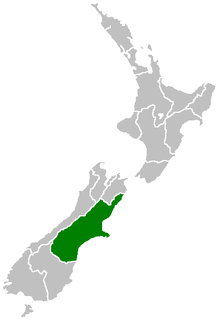
Canterbury is a region of New Zealand, located in the central-eastern South Island. The region covers an area of 44,503.88 square kilometres (17,183.04 sq mi), and is home to a population of 649,800.

Christchurch is the largest city in the South Island of New Zealand and the seat of the Canterbury Region. Christchurch lies on the South Island's east coast, just north of Banks Peninsula on Pegasus Bay. The Avon River / Ōtākaro flows through the centre of the city, with an urban park along its banks. The city's territorial authority population is 392,100 people, and includes a number of smaller urban areas as well as rural areas. The population of the urban area is 380,600 people. Christchurch is the second-largest city by urban area population in New Zealand, after Auckland. It is the major urban area of an emerging sub-region known informally as Greater Christchurch. Notable smaller urban areas within this sub-region include Rangiora and Kaiapoi in Waimakariri District, north of the Waimakariri River, and Rolleston and Lincoln in Selwyn District to the south.

ChristChurch Cathedral, also called Christ Church Cathedral and (rarely) Cathedral Church of Christ, is a deconsecrated Anglican cathedral in the city of Christchurch, New Zealand. It was built between 1864 and 1904 in the centre of the city, surrounded by Cathedral Square. It became the cathedral seat of the Bishop of Christchurch, who is in the New Zealand tikanga of the Anglican Church in Aotearoa, New Zealand and Polynesia.

Trade Me is New Zealand's largest online auction and classifieds website. Managed by Trade Me Ltd., the site was founded in 1999 by New Zealand entrepreneur Sam Morgan, who sold it to Fairfax in 2006 for NZ$700 million. Trade Me was publicly listed as a separate entity on 13 December 2011 under the ticker "TME". In May 2019, Trade Me was acquired by private equity firm Apax Partners for NZ$2.56 billion. Trade Me Ltd also operates several sister websites including FindSomeone and Holiday Houses.

Canterbury Television was an independent television station broadcasting in Canterbury, New Zealand.
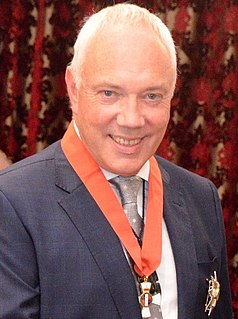
Sir Robert John Parker is a former New Zealand broadcaster and politician. He served as Mayor of Christchurch from 2007 to 2013.
Ushahidi is an open source software application which utilises user-generated reports to collate and map data. It uses the concept of crowdsourcing serving as an initial model for what has been coined as "activist mapping" - the combination of social activism, citizen journalism and geographic information. Ushahidi allows local observers to submit reports using their mobile phones or the Internet, creating an archive of events with geographic and time-date information. The Ushahidi platform is often used for crisis response, human rights reporting, and election monitoring. Ushahidi was created in the aftermath of Kenya's disputed 2007 presidential election that collected eyewitness reports of violence reported by email and text message and placed them on a Google Maps map.

Christchurch Central City or Christchurch City Centre is the geographical centre and the heart of Christchurch, New Zealand. It is defined as the area within the Four Avenues and thus includes the densely built up central city, some less dense surrounding areas of residential, educational and industrial usage, and green space including Hagley Park, the Christchurch Botanic Gardens and the Barbadoes Street Cemetery.
The 2010 Canterbury earthquake struck the South Island of New Zealand with a moment magnitude of 7.1 at 4:35 am local time on 4 September, and had a maximum perceived intensity of X (Extreme) on the Mercalli intensity scale. Some damaging aftershocks followed the main event, the strongest of which was a magnitude 6.3 shock known as the Christchurch earthquake that occurred nearly six months later on 22 February 2011. Because this aftershock was centred very close to Christchurch, it was much more destructive and resulted in the deaths of 185 people.
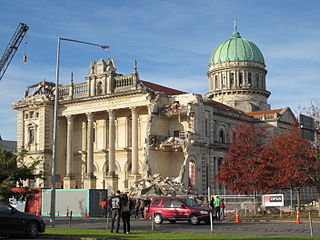
A major earthquake occurred in Christchurch, New Zealand, on Tuesday 22 February 2011 at 12:51 p.m. local time. The Mw6.2 earthquake struck the Canterbury region in the South Island, centred 6.7 kilometres (4.2 mi) south-east of the centre of Christchurch, the country's second-most populous city. It caused widespread damage across Christchurch, killing 185 people, in the nation's fifth-deadliest disaster.

The Canterbury Earthquake Recovery Authority was the public service department of New Zealand charged with coordinating the rebuild of Christchurch and the surrounding areas following the 22 February 2011 earthquake. After it was disestablished on 18 April 2016, CERA's functions were taken over by a variety of other agencies.

The June 2011 Christchurch earthquake was a shallow magnitude 6.0 Mw earthquake that occurred on 13 June 2011 at 14:20 NZST. It was centred at a depth of 7 km (4.3 mi), about 5 km (3 mi) south-east of Christchurch, which had previously been devastated by a magnitude 6.2 MW earthquake in February 2011. The June quake was preceded by a magnitude 5.9 ML tremor that struck the region at a slightly deeper 8.9 km (5.5 mi). The United States Geological Survey reported a magnitude of 6.0 Mw and a depth of 9 km (5.6 mi).
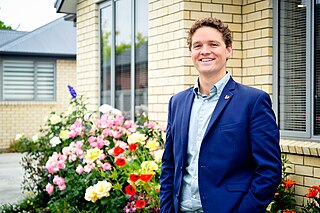
Sam Johnson is a prominent social entrepreneur from Christchurch, New Zealand. Johnson is known as the founder of the Student Volunteer Army which mobilised 11,000 students to assist the cleanup following the Christchurch earthquakes and has continued as a nationwide volunteering movement

The Student Volunteer Army (SVA) is a New Zealand student movement born from a Facebook page started following the 2011 Christchurch earthquake. The network has no military affiliation and is focused on facilitating community action through youth engagement, preparing for disasters, and service. The clubs and volunteers are supported by the Volunteer Army Foundation (VAF).
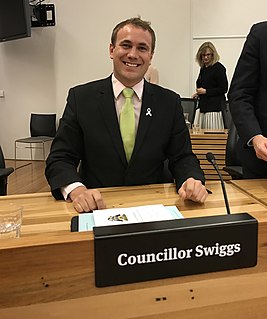
Deon William Swiggs is a former New Zealand politician who served as the Christchurch City Councillor representing the Central ward from 2016 to 2019. Prior to Swiggs being elected, he was most well known for his participation in Rebuild Christchurch, an organisation founded after the 2010 Canterbury earthquake.
The UC CEISMIC Canterbury Earthquakes Digital Archive programme was established in 2011 with the aim of preserving the knowledge, memories and earthquake experiences of people of the Canterbury region. The website provides federated access to a broad range of earthquake-related research material, gathered by leading New Zealand cultural and educational organisations.

An earthquake occurred in Christchurch on 14 February 2016 at 1:13 p.m. local time and initially recorded as 5.9 on the Richter scale, but subsequently reviewed as 5.7. Often referred to as the Valentine's Day earthquake, it was centred in the sea off New Brighton at a depth of 15 kilometres (9.3 mi). It was the first large earthquake that the Christchurch area had experienced since May 2012, and it was part of the earthquake sequence that started with the 4 September 2010 Canterbury earthquake.

The Canterbury Earthquake Recovery Act 2011 was a New Zealand statute that repealed the Canterbury Earthquake Response and Recovery Act 2010 and set out measures to respond to the impact of the Canterbury earthquakes, and in particular the February 2011 Christchurch earthquake.
References
- ↑ Tech volunteers quick to help in quake aftermath Archived 26 February 2011 at the Wayback Machine , Computerword
- ↑ Web acts as virtual crisis centre for Christchurch quake victims, Sydney Morning Herald
- ↑ Social media plays key role after New Zealand earthquake Archived 28 February 2011 at the Wayback Machine , Khou.com
- ↑ "Project update for the Christchurch Recovery Map". crisiscommons.org. 2011. Archived from the original on 4 January 2012. Retrieved 13 July 2011.
- ↑ Call For Information Activists, Voxy.co.nz
- ↑ https://twitter.com/timClicks/status/41979288479739904 [ bare URL ]
- ↑ Christchurch earthquake
- ↑ Information and Resources – Christchurch Earthquake
- ↑ Christchurch earthquake, Google Crisis Response
- ↑ Christchurch Earthquake Support Archived 26 February 2011 at the Wayback Machine , Trademe
- ↑ "Christchurch Recovery Map". eq.org.nz. 2011. Archived from the original on 2 July 2011. Retrieved 13 July 2011.
We recommend you visit http://canterburyearthquake.org.nz/ or call the quake helpline at 0800 779 997 for current information